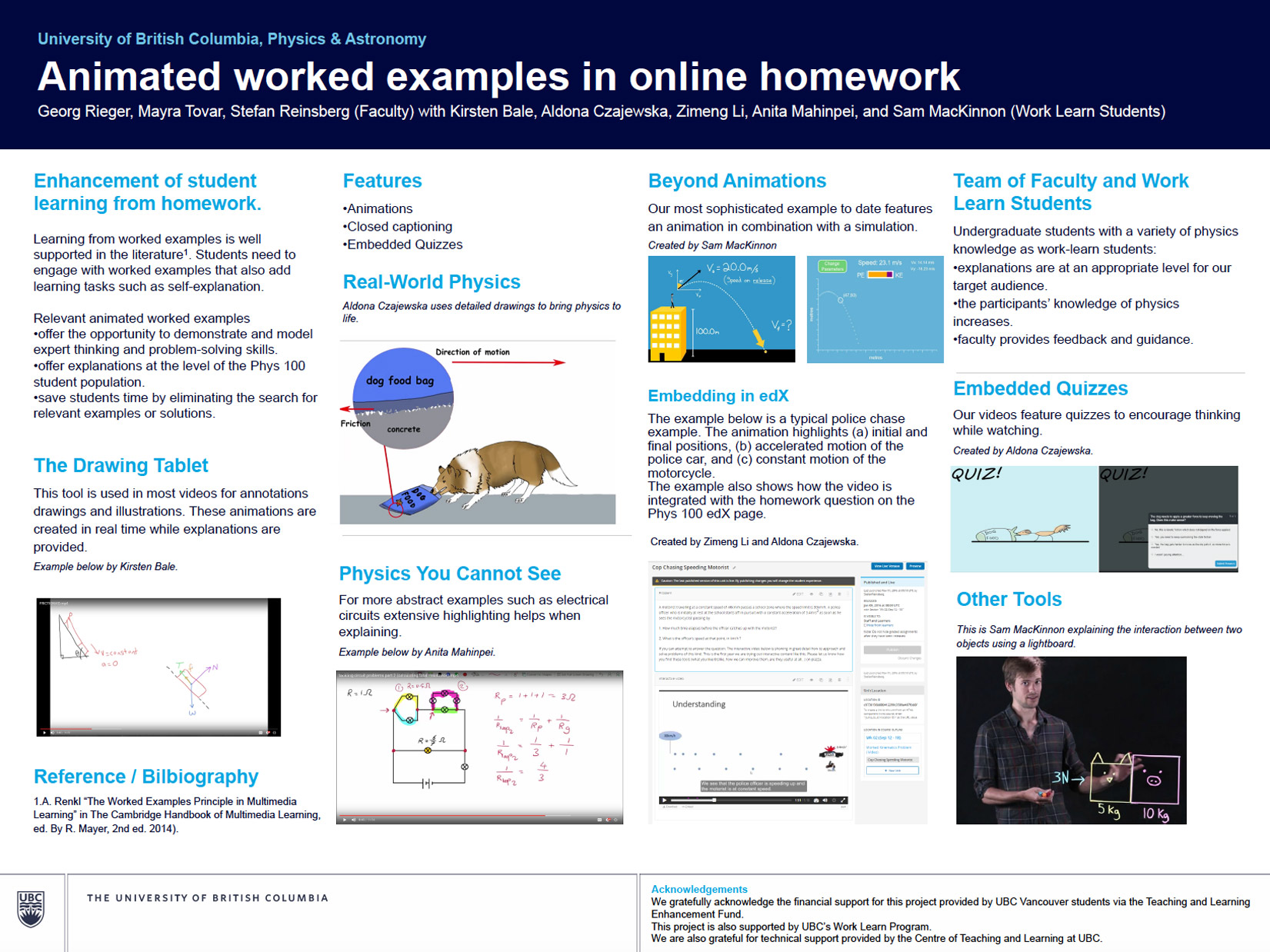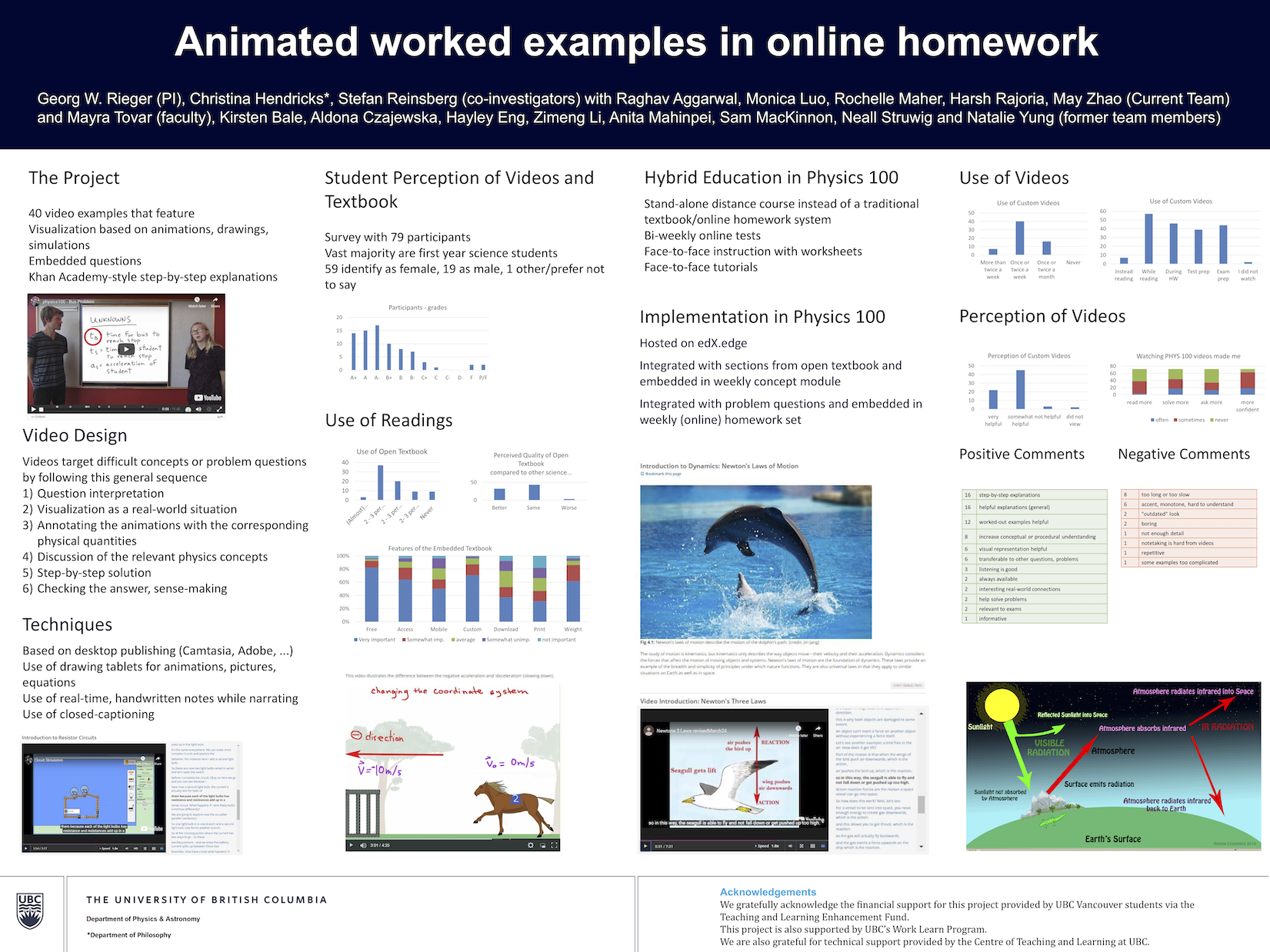| Title | Animated worked examples to support self-directed learning in Physics 100 |
|---|---|
| Faculty/College/Unit | Science |
| Status | Completed |
| Duration | 3 Years |
| Initiation | 04/01/2016 |
| Completion | 08/31/2019 |
| Funding Details | |
| Year 1: Project Title | Animated worked examples in online homework |
| Year 1: Project Year | Year 1 |
| Year 1: Funding Year | 2016/2017 |
| Year 1: Project Type | Small TLEF |
| Year 1: Principal Investigator | Georg Rieger |
| Year 1: Funded Amount | 14,232 |
| Year 1: Team Members | Georg Rieger, Instructor 1, Physics and Astronomy, Faculty of Science |
| Year 1: Summary | The completion of weekly homework sets is common practice in most undergraduate physics courses, especially in first year courses. The homework sets give students the necessary practice with the newly learned content and skills. In large courses, the homework is usually delivered online with automated grading that provides immediate feedback after submission. A recent paper by Gladding et al.* suggests a new approach that has the potential to significantly enhance student learning from online homework. After submission, students can view the full solution to the problem questions in form of animated worked examples before moving on to the next level (or trying a different problem set at the same level). We believe that this strategy would work well for the online homework of our Physics 100 course and propose adding animated worked examples to the difficult problems in the homework sets. The edX platform used in Physics 100 is well suited to implement this strategy. * PRST - PER 11, 010114 (2015) |
| Year 1: TLEF Showcase |  |
| Year 2: Project Year | Year 2 |
| Year 2: Funding Year | 2017/2018 |
| Year 2: Project Type | Small TLEF |
| Year 2: Principal Investigator | Georg Rieger |
| Year 2: Funded Amount | 14,184 |
| Year 2: Team Members | Georg Rieger, Instructor 1, Physics and Astronomy, Faculty of Science |
| Year 2: Summary | The overall goal of the project is to support student learning outside of class. In our first funding year we focused on creating animated worked examples to enhance learning from homework. These video examples demonstrate and illustrate important problem-solving steps for a variety of selected problem questions. Embedded conceptual questions with feedback serve as check points and encourage thinking while watching. Eighteen videos are currently available for Physics 100 and initial student reaction is extremely positive. We will produce more of these examples in our second funding year to support more topics in Physics 100. Furthermore, we will create similar video examples for the pre-class reading assignments that our ‘flipped’ course format relies on. The integration of these videos with the reading will enhance initial conceptual understanding and help students focus on key definitions and concepts. We expect enhanced motivation and conceptual understanding from these pre-class assignments. |
| Year 3: Project Year | Year 3 |
| Year 3: Funding Year | 2018/2019 |
| Year 3: Project Type | Small TLEF |
| Year 3: Principal Investigator | Georg Rieger |
| Year 3: Funded Amount | 12,000 |
| Year 3: Team Members | Georg Rieger, Instructor 1, Physics and Astronomy, Faculty of Science |
| Year 3: Summary | The overall goal of the project is to support student learning outside of class. In our first two funding years we have created 40 video examples, designed to enhance learning from homework and reading assignments. These videos are now integrated in an online resource that is freely available for all PHYS 100 students on edX.edge. In the third funding period we will systematically evaluate the project by addressing the following questions: what percentage of students regularly watches our video examples? Are students finding the examples helpful or motivating? Is there a measurable effect on student performance? We will use surveys, performance on tests and exams, and data available on edX.edge to provide insight into student engagement, attitudes, and learning. We will also facilitate student focus groups to gain a qualitative understanding of why (or why not) students engage with our videos and their perceptions about how the videos influence their learning of course material. |
| Year 3: TLEF Showcase |  |
| Project Report | 2018-TLEF-Final-Rieger-WEB.pdf |